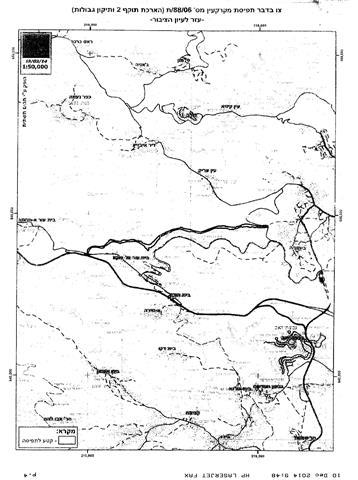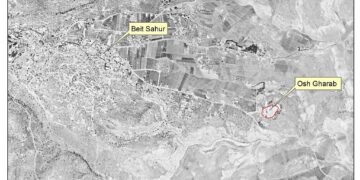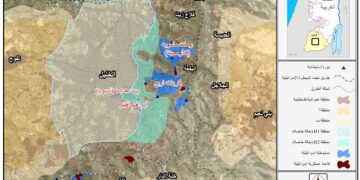On the 10th of December 2014, the Israeli Occupation Authorities handed Palestinians in Ein Arik, Beit Ur Al Fuqa villages and Betunyia town in Ramallah Governorate a new military order titled 88/06/T (extension No. 2 & border amendment) and signed by Netzan Alon, head central command in the Israeli occupation Army in the occupied West Bank. The order states to extend the confiscation of 321 dunums of land in the aforementioned communities for security purposes. Table 1 gives details of the military order
|
Table 1: Details of the Israeli military order No. 88/06/T (extension No. 2) |
|||
|
No. |
Community Name |
Block No. |
Parcel No. |
|
1 |
Beit Ur Al Fuqa |
2 |
1-11, 18, 24, 25, 27, 28, 30, 36, 34-38 |
|
3 |
7, 11, 12, 14, 16-19 |
||
|
2 |
Betunyia |
12 |
42,43,76 |
|
13 |
19-22, 24-26, 53, 56, 60-82, 86, 87 |
||
|
33 |
12, 5, 8, 10, 14-17, 19 |
||
|
35 |
73, 77, 78 |
||
|
3 |
Ein Arik |
6 |
16-19, 21, 23 |
|
7 |
27-31, 32, 36 |
||
|
8 |
38, 40, 41 |
||
|
9 |
11, 13-15 |
||
|
Source: Betunyia Municipality, Ramallah – 2014 |
|||
Photo 1 & Photo 2: The Israeli military order 88/06/T
Map 1: Map of the Israeli military order No. 88/06/T
This is not the first time that the Israeli occupation authorities issue such orders, where back in years, Israel issued tens of military orders which stipulated the extension of validity and borders amendment to previously issued military orders, in an attempt to extend its control over the land it targets in the order, so that it can implement its settlement plans in the targeted area.
With regard to military order No. (88/06/T) (Ext. 2 & border amendment), the order was first issued back in February of 2008 and stated the confiscation of 578.99 dunums of land in Betunyia and Beit Ur al-Fuqa communities, to construct what Israel called the “fabric of life” road, to create a territorial contiguity between villages of Beit Ur al-Fuqa and Beit Ur al-Tahta and the neighboring villages in the western part of Ramallah Governorate with Betunyia town and Ramallah city center. This road is intended to make Palestinians replace their use of bypass road No. 443 with this new road as an “alternative route” to Ramallah in the future, so that at the end, Israel maintains sole use of the bypass road No. 443 for settlers and the army.
In recent years, the Israeli Occupation Authorities (IOA) tended to not give Palestinians a chance to file petitions against the issued military orders; and to do so, the IOA deliberately hands over the orders to Palestinians after the expiration of the legal period provided for them to object the order, which is often seven days, beginning on the date of signing of the military order; thus obstructing the Palestinians legal right in that matter.
Order Analysis
An Analysis conducted by the Applied Research Institute – Jerusalem (ARIJ) of the issued military order and the attached maps, Israel wants to extend its control over the targeted land so that it completes the rehabilitation of the road leading to Betunyia city (parallel to bypass road 443), under the pretext of easing the movement of Palestinians in the area; while at the same, Israel is trying to impose a discriminatory policy between Palestinians and settlers on this road to protect settlers movement; thus, giving a legal cover to the confiscation of Palestinian land in the area and consequently depriving Palestinians their right to use the bypass road No. 443 which was originally constructed on a previously confiscated Palestinian land.
Photo 3: Map of the military order 88/06/T (Ext. No. 2 and border amendment)
Creating a Network of Alternative Roads for Palestinians
The Israeli bypass road no. 443 links the city of Ramallah with Palestinian villages to the south-west of the city, such as Saffa, Beit Sira, Kharbatha Al Misbah, Beit Ur al-Tahta, Beit Ur al Fuqa, At Tira, and Betunyia. Following the eruption of the second Intifada in September 2000, the area witnessed several incidents between Palestinians and settlers living in settlements in the area, which motivated the Israeli Occupation Army to close the road in the face of Palestinians in 2002 but kept it open to Israeli settlers without taking into account the negative impact such a closure will cause to Palestinians. Following the closure of the road, Palestinians of the aforementioned communities were forced to take a long alternative road which took them from 45 minutes to one hour time, while it used to take them around 10 minutes to drive on bypass road 443 to reach the same destination. This alternative road is part of an Israeli scheme to create two networks of roads in the occupied West Bank, one for Israeli settlers and army while another for Palestinians.
Palestinian access to bypass road No. 443 was denied until the late 2010 when the Israeli Supreme Court issued an order requesting the Israeli Occupation army to lift the ban imposed on Palestinians traveling on bypass road number 443. The court ruling described the ban as 'unauthorized and disproportional' The Court also gave the Israeli Occupation army a period of five months to find a solution on how to provide security and protection to Israeli settlers driving on the road, while at the same time, allow Palestinians to use the road. However, it is clear that Palestinians were and are still the ones to pay the price of the Israeli security arrangements on bypass road 443 and other roads in the occupied West Bank territory as tens of military orders were issued to confiscate Palestinian land for that purpose.
To conclude,
With regard to Palestinians, instead of applying the law, Israel circumvents the law in favor of its settlement plans. It is worth mentioning that Israel is exploiting the areas under its control ("Area C"), in the West Bank so that it can control the largest possible area of the Palestinian territory, before reaching a peace agreement with the Palestinians.
Despite local and international condemnation of the Israeli land confiscation in the occupied Palestinian territory, Israel continues with its settlement program in its various forms, and continue funding settlements in this regard, where most recently, it was reported by the Israel Hayom website on the 9th of December of 2014, that the Knesset Finance Committee approved the allocation of over 220 million shekels (some $56 million) for settlements and settlement education in the occupied West Bank.
Prepared by:
The Applied Research Institute – Jerusalem

















